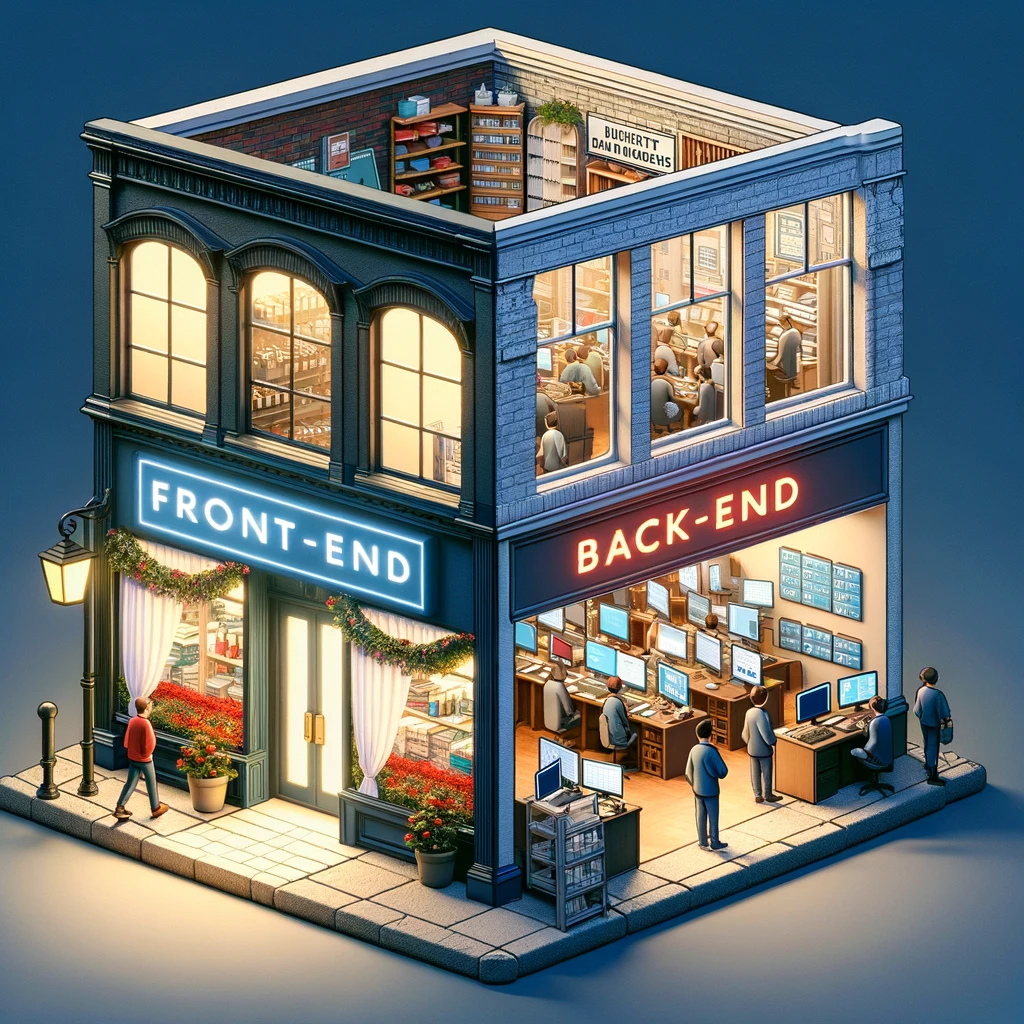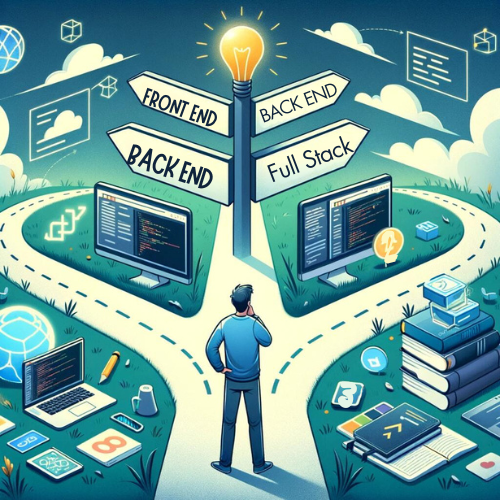What Is The Difference Between Front End And Back End Web Development? Front End is the side that you interact with, the layout, the buttons, the images – everything your eye perceives and your mouse clicks.
This realm uses languages like JavaScript, HTML, and CSS to not only craft something pleasing to look at but also to ensure it’s interactive and responds to your actions. Picture yourself walking into a store, front-end developers design the storefront making sure it’s both attractive and easy to navigate.

Now, what about back-end development? Imagine the store’s back office – the place where inventory, orders, and data are managed. That’s the back-end in the digital world. It’s less about aesthetics and more about functionality. Back-end developers handle the server-side, working with applications, databases, and server management. Their tools aren’t visual but are crucial nonetheless because they ensure that the information and functionalities you want are delivered to you swiftly and securely.
When you combine the two you get a user-friendly website or application.And knowing the difference between these two can be quite handy, whether you’re looking to become a developer or just trying to communicate more effectively with your tech team.
Let’s dive into the differences together.
What is Front End Web Development?
I’m going to zero in on what makes front-end development so unique and crucial. You might have heard about the languages front-end developers swear by: HTML, CSS, and JavaScript. Together, they’re the nuts and bolts of website interfaces, the part you interact with every day. HTML lays out the structure, CSS adds style, and JavaScript breathes interactivity into the static skeleton. It’s a symphony of code that crafts everything from that button you click to submit a form, to the responsive design that adapts to your mobile screen.

That’s not the end of the story though. Frameworks and libraries, think of them as the tools that make building complex sites more efficient, are also in every front-end dev’s toolkit. We’re talking about powerhouses like Bootstrap, which helps create mobile-ready sites, and AngularJS, the hero for single-page applications. They’re part of the evolution from writing every line of code from scratch to a modular approach, where reuse and efficiency lead the charge.
Learn about the top five frameworks
This isn’t just about technical skills; front-end development is also about the artistry of design. A keen eye for aesthetics and user experience is often as important as coding prowess. Picture this, front-end pros need to translate a designer’s vision into a functional website. It’s like turning a storyboard into a blockbuster film, but for the web.
Now, let’s talk shop for a minute. If you’re eyeing a career on the front lines of website creation, you’re looking at a field where the demand is as dynamic as the skill set. The average annual salary for front-end developers hovers around $83,000. But money aside, this role puts you in the collaborative heart of project teams, working alongside designers, back-end developers, and quality assurance analysts to create an integrated, user-focused product.
In closing, front-end development is not just coding – it’s a meeting point of technology, design, and user experience. Choose something that resonates with you: if it’s the vision and visuals that draw you in, front-end development might just be your stage. But don’t forget, there’s another side to this world, one that’s equally critical in bringing digital experiences to life – back-end development, which I’m going to cover next.
What is Back End Web Development?
If you’re curious about what goes on under the hood of your favorite websites, back-end development is where the magic happens. It’s the part you don’t see but is crucial for the functionality and performance of a site. Back-end developers are the architects who build the structure that supports and brings life to the designers’ visions. They ensure that data flows smoothly between the server, application, and database.

The languages that dominate this space are powerhouses like Java, Python, and Ruby. They’re the tools used to construct databases, manage user connections, and process business logic. A back-end developer’s knowledge isn’t just confined to these languages. They also need to be proficient in managing databases with tools like SQL Server and Oracle, which are essential for storing and retrieving data efficiently.
In the ecosystem of web applications, the back end is what allows the front-end components to function. Think of it like stage crew in a theater production—they make sure that the show runs without a hitch, though they’re not in the spotlight. Back-end devs craft the APIs and write the server-side code that connects everything together. Their work enables users to perform actions such as making a purchase, signing up for an account, or searching for content.
Turning our gaze to the job market, back-end developers are highly sought after. The reason is clear: they ensure that websites are scalable, secure, and functional. They troubleshoot and devise solutions for when things go wrong—which they inevitably do. With an average annual salary of around $92,000 they’re compensated well for their critical role in web development.
A back-end developer’s day-to-day tasks are varied, involving writing code, testing and debugging, and attending to the less glamorous but vital aspects of web development—security, and data protection. It’s a field that’s both challenging and rewarding, with constant learning opportunities due to technological advances.
What is Full Stack Development
Think of full-stack developers as the Swiss Army knives of the web development world. They’re not just jacks-of-all-trades; they’re masters of integration, possessing an arsenal of both front-end and back-end skills. Understanding the complete architecture of web applications, they can work on both the client and server sides, making them extremely valuable in the tech industry.

You’re going to find out about how full-stack developers manage to keep a foothold in both camps. These multitasking wizards are fluent in HTML, CSS, and JavaScript, but they also toggle effortlessly to server-side languages like Python and Node.js. This full-spectrum skill set allows them to see projects through from conceptualization to execution.
There’s a lot of opportunity in becoming a full-stack developer. They often lead projects because they understand all the layers of the tech stack, and this broad perspective enables them to troubleshoot complex issues that span multiple systems. Moreover, their versatility allows them to slip into diverse roles, which is a boon in agile and lean development environments.
I’m here to help you understand the educational path to becoming a full-stack developer. It isn’t merely about piling on a variety of coding languages. It’s about learning how these technologies interact, how data flows from user inputs to database storage and back again, and how to create secure, scalable websites.
Choose something that resonates with you. If full-stack development excites you, start with the basics of front-end and back-end development, and gradually build your expertise by tackling larger, integrated projects over time. Just don’t focus too much on perfection; your first attempt doesn’t need to be your last. Iterative learning and continuous improvement are part and parcel of the developer’s journey.
Where to go for Education and Careers in Web Development
So you’re at a crossroads, trying to decide which path in web development is right for you. My advice? Assess your interests and strengths. If you revel in crafting visuals and user interactions, front-end development might just be your playground. On the other hand, if you find satisfaction in logical problem solving and managing data, the back-end could be calling your name. And if you can’t choose, maybe full-stack is your answer, offering the best of both worlds.

As for education, there’s good news. The web development field is rich with learning opportunities. From bootcamps to online courses, many of which are self-paced and even free, you can start piecing together your dream career piece by piece. Certifications can also give you a leg up, showcasing your commitment and expertise to potential employers.
Now, let’s quickly answer some of those burning questions you might have. In terms of pay, both front-end and back-end roles offer competitive salaries, with back-end slightly leading. But remember, this fluctuates with experience, location, and demand. As for difficulty, it’s subjective. Front-end can seem more visually rewarding early on, while back-end offers deep satisfaction as complex systems come to life. Ultimately, either one requires dedication to master.
If you’re still in doubt about where to start—front-end or back-end—I say, dip your toes in both ponds. Give yourself a taste of each and see what captivates you more. And remember, your first attempt doesn’t need to be your last. The tech field evolves, and so can your career. Choose something that resonates with you now, knowing you can always adjust your approach down the road.
Are you ready to dip your toes in front end, back end, or full stack? I know you are.
Thank you for reading my post. Leave your comments below to participate in this engaging community. Be sure to sign up to receive updates of more incredible articles.
I have been in the web development industry since 2016. It is my desire to guide aspiring and seasoned developers alike through the complex landscape of web development and software engineering. I combine my academic prowess, with degrees from Western Governor University and a Boot Camp certificate from Bloom Tech, with real-world experience to educate and inspire.
As the force behind DevTuneUp.com, I offer a treasure trove of tutorials, how-tos, and insights into the ever-evolving tech industry. With a sharp focus on demystifying technology and a goal to make DevTuneUp.com a cornerstone for tech enthusiasts, I leverage my expertise in SEO optimization and social media marketing to reach and empower a global audience. Join me on this journey to navigate the digital world with confidence and skill.
Hey Jordan,
This excellent piece of writing provides a detailed explanation of the distinctions between front-end and back-end web development. It offers a clear and engaging summary of each domain’s unique roles and technologies, making it simple to grasp even for those who are new to the subject matter. The analogy of a storefront and back office effectively illustrates the user-facing aspects of front-end development and the more functional, behind-the-scenes nature of back-end development. Furthermore, the article’s examination of full-stack development and career choices in web development provides valuable guidance for anyone considering a career in this field. Overall, the article is a comprehensive resource that demystifies complex technical concepts in an accessible manner.
Anyone interested in web development or building complex web applications must understand front-end and back-end web development. On the client side, front-end development handles everything users do in their web browser. This includes website layout, design, and interactivity using HTML, CSS, and JavaScript to create a user-friendly interface.
The server side of a web application is the focus of back-end development. It covers database interactions, user authentication, server logic, and APIs for front-end applications to display data. Python, Ruby, Java, and Node. A functional, efficient, and seamless web experience requires front-end and back-end development. Front-end developers make the website look good, intuitive, and responsive, while back-end developers make sure it works, loads quickly, and connects to a database for data retrieval and storage. Full-stack developers often have expertise in both areas, making them ideal for web development.
Web applications succeed when front-end and back-end development are balanced and integrated, so developers, project managers, and others involved in web technology creation should understand both.
Thank you for explaining these! I had a basic idea of what the front end and back end of a website were, but now I understand much better. I didn’t realize that working with some of the code (HTML, JavaScript, and CSS) was still working with the front end of the website.
By the way, cool pictures!!
What a comprehensive breakdown of front-end and back-end development! I appreciate how you’ve simplified complex concepts into digestible nuggets. My burning question after reading this is: for someone new to web development, what resources or courses would you recommend to get started in either front-end or back-end development? Looking forward to hearing your insights!
Pluralsight and Educative is good
Hi Jordan.
When I started to read your article. I wondered if someone like me with a marketing, non-techy background needed this kind of information. A few sentences in, though, I ran into your statement about knowing enough to be able to communicate more effectively with a tech team and that got me hooked. Communication is critical, and the more you know about a person’s world, the better you can be at communicating with them.
It was also quite intriguing to find out the average salaries of both Front-end and Back-end developers. I even clicked on the link to find out more. It may be a bit late for me, but it might just make a difference in the career decisions of my younger nephews and nieces.
Thanks for this insightful post.
its probably never too late unless your close to retirement